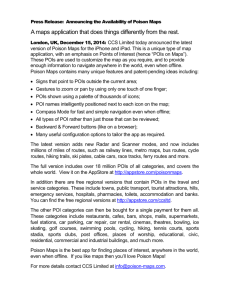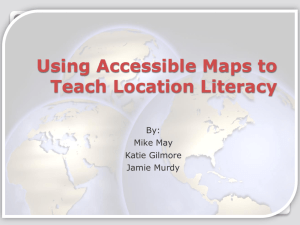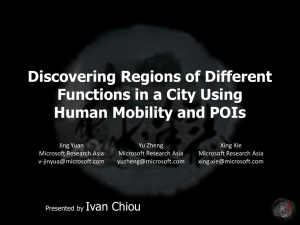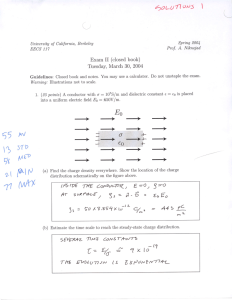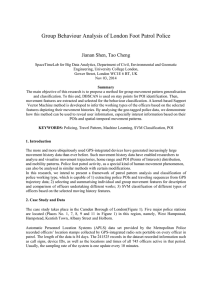Personalized Tour Recommendation Based on
advertisement
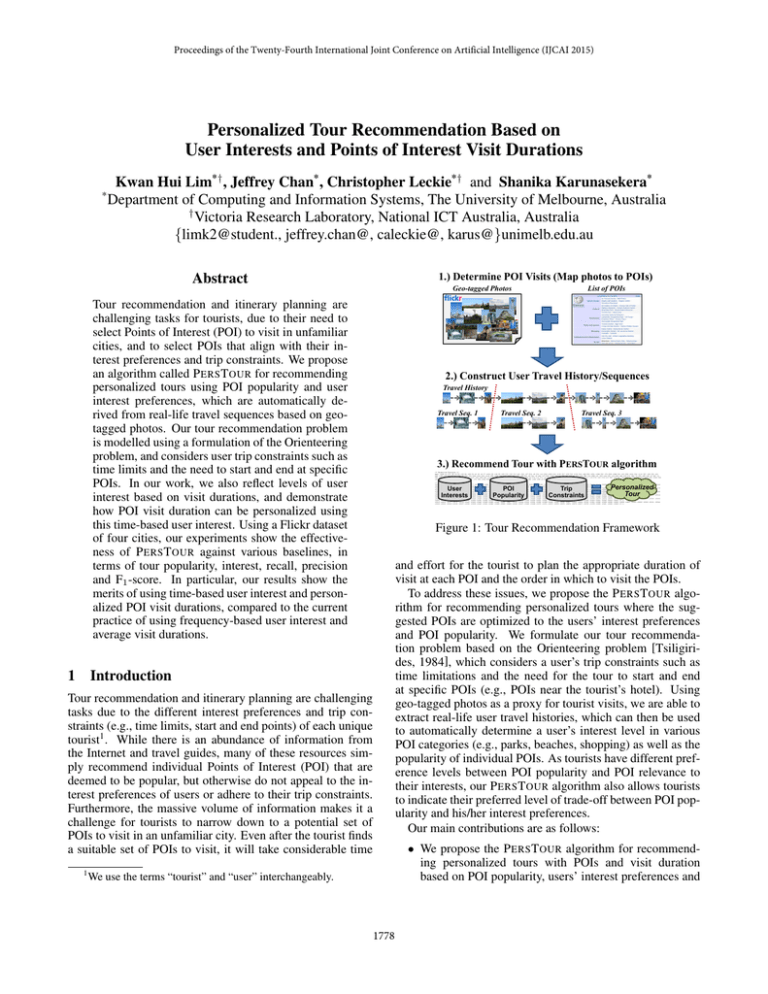
Proceedings of the Twenty-Fourth International Joint Conference on Artificial Intelligence (IJCAI 2015)
Personalized Tour Recommendation Based on
User Interests and Points of Interest Visit Durations
*
Kwan Hui Lim*† , Jeffrey Chan* , Christopher Leckie*† and Shanika Karunasekera*
Department of Computing and Information Systems, The University of Melbourne, Australia
†
Victoria Research Laboratory, National ICT Australia, Australia
{limk2@student., jeffrey.chan@, caleckie@, karus@}unimelb.edu.au
1.) Determine POI Visits (Map photos to POIs)
Abstract
Geo-tagged Photos
Tour recommendation and itinerary planning are
challenging tasks for tourists, due to their need to
select Points of Interest (POI) to visit in unfamiliar
cities, and to select POIs that align with their interest preferences and trip constraints. We propose
an algorithm called P ERS T OUR for recommending
personalized tours using POI popularity and user
interest preferences, which are automatically derived from real-life travel sequences based on geotagged photos. Our tour recommendation problem
is modelled using a formulation of the Orienteering
problem, and considers user trip constraints such as
time limits and the need to start and end at specific
POIs. In our work, we also reflect levels of user
interest based on visit durations, and demonstrate
how POI visit duration can be personalized using
this time-based user interest. Using a Flickr dataset
of four cities, our experiments show the effectiveness of P ERS T OUR against various baselines, in
terms of tour popularity, interest, recall, precision
and F1 -score. In particular, our results show the
merits of using time-based user interest and personalized POI visit durations, compared to the current
practice of using frequency-based user interest and
average visit durations.
1
2.) Construct User Travel History/Sequences
Travel History
Travel Seq. 1
Travel Seq. 2
Travel Seq. 3
3.) Recommend Tour with PERSTOUR algorithm
User
Interests
POI
Popularity
Trip
Constraints
Personalized
Tour
Figure 1: Tour Recommendation Framework
and effort for the tourist to plan the appropriate duration of
visit at each POI and the order in which to visit the POIs.
To address these issues, we propose the P ERS T OUR algorithm for recommending personalized tours where the suggested POIs are optimized to the users’ interest preferences
and POI popularity. We formulate our tour recommendation problem based on the Orienteering problem [Tsiligirides, 1984], which considers a user’s trip constraints such as
time limitations and the need for the tour to start and end
at specific POIs (e.g., POIs near the tourist’s hotel). Using
geo-tagged photos as a proxy for tourist visits, we are able to
extract real-life user travel histories, which can then be used
to automatically determine a user’s interest level in various
POI categories (e.g., parks, beaches, shopping) as well as the
popularity of individual POIs. As tourists have different preference levels between POI popularity and POI relevance to
their interests, our P ERS T OUR algorithm also allows tourists
to indicate their preferred level of trade-off between POI popularity and his/her interest preferences.
Our main contributions are as follows:
Introduction
Tour recommendation and itinerary planning are challenging
tasks due to the different interest preferences and trip constraints (e.g., time limits, start and end points) of each unique
tourist1 . While there is an abundance of information from
the Internet and travel guides, many of these resources simply recommend individual Points of Interest (POI) that are
deemed to be popular, but otherwise do not appeal to the interest preferences of users or adhere to their trip constraints.
Furthermore, the massive volume of information makes it a
challenge for tourists to narrow down to a potential set of
POIs to visit in an unfamiliar city. Even after the tourist finds
a suitable set of POIs to visit, it will take considerable time
1
List of POIs
• We propose the P ERS T OUR algorithm for recommending personalized tours with POIs and visit duration
based on POI popularity, users’ interest preferences and
We use the terms “tourist” and “user” interchangeably.
1778
ing an optimal set of POIs based on both POI popularity
and user interest. Thereafter, [Brilhante et al., 2015] extended upon the former by using a variation of the Travelling
Salesman Problem, with the main aim of finding the shortest
route among the set of optimal POIs recommended in [Brilhante et al., 2013]. In addition to user interests in tour recommendation, [Chen et al., 2014] also considered travelling
times based on different traffic conditions, using trajectory
patterns derived from taxi GPS traces. With further considerations for different transport modes, [Kurashima et al., 2010;
2013] used a combined topic and Markov model to recommend tours based on both user interests and frequently travelled routes.
While these earlier works are the state-of-the-art in tour
recommendation research, our proposed work differs from
these earlier works in two main aspects: (i) instead of using
frequency-based user interest (by POI visit frequency) or requiring users to explicitly indicate their interest preferences,
we derive a relative measure of time-based user interest using
a user’s visit durations at POIs of a specific category, relative
to the average visit durations of other users; (ii) we recommend a personalized POI visit duration to individual users
based on their time-based user interests, instead of using the
average POI visit duration for all users or not considering visit
duration at all.
trip constraints. Our tour recommendation problem is
modelled in the context of the Orienteering problem
(Section 3).
• We introduce the concept of time-based user interest,
where a user’s level of interest in a POI category is based
on his/her time spent at such POIs, relative to the average user. We also compare our time-based user interest
to the current practice of using frequency-based user interest, and show how time-based user interest results in
recommended tours that more accurately reflect real-life
travel sequences (Section 3.1).
• We demonstrate the personalization of POI visit duration using time-based user interest. Our results show
that personalized visit durations more accurately reflect
the real-life POI visit durations of users, compared to
the current practice of using average visit duration (Section 3.1).
• We implement a framework (Fig. 1) for extracting reallife user travel histories, which are then used for training
our P ERS T OUR algorithm and serve as ground truth for
our subsequent evaluation (Section 4).
• We evaluate different variants of P ERS T OUR against
various baselines using a Flickr dataset spanning four
cities. Our results show that P ERS T OUR out-performs
these baselines based on tour popularity, user interest,
recall, precision and F1 -score (Sections 5 and 6).
For the rest of the paper: Section 2 discusses related work
in tour recommendation, and Section 7 concludes our paper.
2
3
3.1
Background and Problem Definition
Preliminaries
If there are m POIs for a particular city, let P = {p1 , ..., pm }
be the set of POIs in that city. Each POI p is also labelled
with a category Catp (e.g., church, park, beach) and latitude/longitude coordinates. We denote a function P op(p)
that indicates the popularity of a POI p, based on the number of times POI p has been visited. Similarly, the function
T T ravel (px , py ) measures the time needed to travel from POI
px to py , based on the distance between POIs px and py and
the indicated travelling speed. For simplicity, we use a travelling speed of 4km/hour (i.e., a leisure walking speed).2
Definition 1: Travel History. Given a user u who has visited n POIs, we define his/her travel history as an ordered
sequence, Su = ((p1 , tap1 , tdp1 ), ..., (pn , tapn , tdpn )), with each
triplet (px , tapx , tdpx ) comprising the visited POI px , and the
arrival time tapx and departure time tdpx at POI px . Thus,
the visit duration at POI px can be determined by the difference between tapx and tdpx . Similarly, for a travel sequence Su , tap1 and tdpn also indicates the start and end time
of the itinerary respectively. For brevity, we simplify Su =
((p1 , tap1 , tdp1 ), ..., (pn , tapn , tdpn )) as Su = (p1 , ..., pn ).
Definition 2: Travel Sequence. Based on the travel history Su of a user u, we can further divide this travel history
into multiple travel sequences (i.e., sub-sequences of Su ). We
divide a travel history Su into separate travel sequences if
Related Work
Tour recommendation has been a well-studied field, with
many developed applications [Vansteenwegen and Oudheusden, 2007; Castillo et al., 2008; Brilhante et al., 2014] and
research ranging from recommending beautiful, quiet, and
happy tours [Quercia et al., 2014] to tour recommendation using random walks with restart [Lucchese et al., 2012]. In this
section, we focus on research related to our work, and refer
readers to [Souffriau and Vansteenwegen, 2010] and [Damianos Gavalas, 2014] for an overview on the general field of
tour recommendation.
[Choudhury et al., 2010] was one of the earlier tour recommendation studies based on the Orienteering problem, where
recommended tours start and end at specific POIs while trying to maximize an objective score. Using a modified Orienteering problem, [Gionis et al., 2014] utilized POI categories such that recommended tours are constrained by a POI
category visit order (e.g., museum → park → beach). Similarly, [Lim, 2015] used a modified Orienteering problem constrained by a mandatory POI category, which corresponds
to the POI category a user is most interested in. Based on
user-indicated interests and trip constraints (e.g., time budget,
start and end locations), [Vansteenwegen et al., 2011a] recommended tours comprising POI categories that best match
user interests while adhering to these trip constraints.
In contrast, [Brilhante et al., 2013] formulated tour recommendation as a Generalized Maximum Coverage problem [Cohen and Katzir, 2008], with the objective of find-
2 T ravel
T
(px , py ) can be easily generalized to different transport
modes (e.g., taxi, bus, train) and also consider the traffic condition
between POIs (e.g., longer travel times between two POIs in a congested city, compared to two equal-distanced POIs elsewhere).
1779
tdpx −tapx +1 > τ . That is, we separate a travel history into distinct travel sequences if the consecutive POI visits occur more
than τ time units apart. Similar to other works [Choudhury et
al., 2010; Lim, 2015], we choose τ = 8 hours in our experiments. These travel sequences also serve as the ground truth
of real-life user trajectories, which are subsequently used for
evaluating our P ERS T OUR algorithm and baselines.
Definition 3: Average POI Visit Duration. Given a set of
travel histories for all users U , we determine the average visit
duration for a POI p as follows:
1X X d
V̄ (p) =
(tpx − tapx )δ(px = p),
∀ p ∈ P (1)
n
req
is in that category). As using IntF
(c) is the current pracu
tice in tour recommendation research [Brilhante et al., 2013;
Lim, 2015; Brilhante et al., 2015], we include it for a more
complete study and as a comparison baseline to our proposed
IntTu ime (c).
3.2
We now define our tour recommendation problem in the context of the Orienteering problem and its integer problem formulation [Tsiligirides, 1984; Vansteenwegen et al., 2011b;
Lim, 2015]. Given the set of POIs P , a budget B, starting POI p1 and destination POI pN , our goal is to recommend an itinerary I = (p1 , ..., pN ) that maximizes a certain score S while adhering to the budget B. In this case,
the score S is represented by the popularity and user interest
of the recommended POIs using the functions P op(p) and
Int(Catp ), respectively. The budget B is calculated using
the function Cost(px , py ) = T T ravel (px , py ) + TuV isit (py ),
i.e., using both travelling time and personalized visit duration
at the POI. One main difference between our work and earlier
work is that we personalize the visit duration at each recommended POI based on user interest (Definition 5), instead of
using the average visit duration for all users or not considering visit duration at all. Formally, we want to find an itinerary
I = (p1 , ..., pN ) that:
u∈U px ∈Su
where n is the number of visits to POI p by all users and
px =p
δ(px =p) = {1,
0, otherwise . V̄ (p) is commonly used in tour
recommendation as the POI visit duration for all users [Brilhante et al., 2013; 2015; Chen et al., 2014], while many earlier works do not factor in POI visit durations at all. In our
work, we show how recommended POI visit durations can be
personalized to individual users based on their interest (Definition 5), and use V̄ (p) as a comparison baseline (i.e., the
non-personalized POI visit duration).
Definition 4: Time-based User Interest. As described
earlier, the category of a POI p is denoted Catp . Given that
C represents the set of all POI categories, we determine the
interest of a user u in POI category c as follows:
IntTu ime (c) =
M ax
=c
px
where δ(Catpx =c) = {0, otherwise
. In short, Eqn. 2 determines the interest of a user u in a particular POI category c,
based on his/her time spent at each POI of category c, relative
to the average visit duration (of all users) at the same POI.
The rationale is that a user is likely to spend more time at
a POI that he/she is interested in. Thus, by calculating how
much more (or less) time a user is spending at POIs of a certain category compared to the average user, we can determine
the interest level of this user in POIs of this category.
Definition 5: Personalized POI Visit Duration. Based
on our definition of time-based user interest (Eqn. 2), we are
able to personalize the recommended visit duration at each
POI based on each user’s interest level. We determine the
personalized visit duration at a POI p for a user u as follows:
TuV isit (p) = IntTu ime (Catp ) ∗ V̄ (p)
xi,j ηInt(Cati ) + (1 − η)P op(i)
(4)
where xi,j = 1 if both POI i and j are visited in sequence
(i.e., we travel directly from POI i to j), and xi,j = 0 otherwise. We attempt to solve for Eqn. 4, such that:
u
1, Cat
N
N
−1 X
X
i=2 j=2
X (tdp − tap )
x
x
δ(Catpx =c), ∀ c ∈ C (2)
V̄
(p
)
x
p ∈S
x
Problem Definition
N
X
x1,j =
j=2
N
−1
X
i=1
xi,k =
N
X
N
−1
X
xi,N = 1
(5)
i=1
xk,j ≤ 1,
∀ k = 2, ..., N − 1
(6)
j=2
N
−1 X
N
X
Cost(i, j)xi,j ≤ B
(7)
i=1 j=2
2 ≤ pi ≤ N,
∀ i = 2, ..., N
(8)
pi − pj + 1 ≤ (N − 1)(1 − xi,j ),
∀ i, j = 2, ..., N (9)
Eqn. 4 is a multi-objective function that maximizes the
popularity and interest of all visited POIs in the itinerary,
where η is the weighting given to the popularity and interest components. Eqn. 4 is also subject to constraints 5 to 9.
Constraint 5 ensures that the itinerary starts at POI 1 and ends
at POI N , while constraint 6 ensures that the itinerary is connected and no POIs are visited more than once. Constraint 7
ensures that the time taken for the itinerary is within the budget B, based on the function Cost(px , py ) that considers both
travelling time and personalized POI visit duration. Given
that px is the position of POI x in itinerary I, constraints 8
and 9 ensure that there are no sub-tours in the proposed solution, adapted from the sub-tour elimination used in the Travelling Salesman Problem [Miller et al., 1960].
(3)
That is, we are recommending a personalized POI visit duration based on user u’s relative interest level in category Catp
multiplied by the average time spent at POI p. Thus, if a user
is more (less) interested in category Catp , he/she will spend
more (less) time at POI p than the average user.
Definition 6: Frequency-based User Interest. We
also define a simplified version of user interest, denoted
req
IntF
(c), which is based on the number of times a user
u
visits POIs of a certain category c (i.e., the more times a user
visits POIs of a specific category, the more interested this user
1780
Based on this problem definition, we can then proceed
to solve our tour recommendation problem as an integer
programming problem. For solving this integer programming problem, we used the lpsolve linear programming package [Berkelaar et al., 2004]. We denote our proposed algorithm for personalized tour recommendation as P ERS T OUR,
and shall describe our overall framework and the different
P ERS T OUR variants in the following section.
4
Table 1: Dataset description
City
Toronto
Osaka
Glasgow
Edinburgh
Tour Recommendation Framework
No. of
Photos
157,505
392,420
29,019
82,060
No. of
Users
1,395
450
601
1,454
# POI
Visits
39,419
7,747
11,434
33,944
# Travel
Sequences
6,057
1,115
2,227
5,028
frequency-based interest. As PT-0 does not consider user
interest, there is no need to choose between time-based or
frequency-based user interest.
Fig. 1 outlines our overall tour recommendation framework.
This framework requires a list of POIs (with lat/long coordinates and POI categories) and a set of geo-tagged photos
(with lat/long coordinates and time taken), which can be easily obtained from Wikipedia and Flickr, respectively. Thereafter, the main steps in our framework are:
Step 1: Determine POI visits (Map photos to POIs). We
first determine the POI visits in each city by mapping the set
of geo-tagged photos to the list of POIs. In particular, we map
a photo to a POI if their coordinates differ by <200m based
on the Haversine formula [Sinnott, 1984], which is used for
calculating spherical (earth) distances.
Step 2: Construct Travel History/Sequences. Based on
the POI visits from Step 1, we can construct the travel history of each user by sorting their POI visits in ascending
temporal-order (Definition 1). Using each user’s travel history, we then proceed to group consecutive POI visits as an
individual travel sequence, if the consecutive POI visits differ
by <8 hours (Definition 2). Thus, we are also able to determine the POI visit duration based on the time difference of
the first and last photo taken at each POI.
Step 3: Recommend Tours using P ERS T OUR. As described in Section 3.2, there can be different variants of P ER S T OUR , based on the value of η and the type of interest function chosen. The value of η indicates the weight given to
either POI popularity or user interest, while the interest function can be either time-based interest (IntTu ime ) or frequencyreq
based interest (IntF
). We experiment with the following
u
variants:
• P ERS T OUR using η=0 (PT-0). P ERS T OUR with full
emphasis on POI popularity, ignoring user interest (i.e.,
req
no need to choose between IntTu ime or IntF
).
u
T ime
• P ERS T OUR using Intu
and η=0.5 (PT-.5T). P ER S T OUR with balanced emphasis on optimizing both POI
popularity and time-based user interest.
req
• P ERS T OUR using IntF
and η=0.5 (PT-.5F). P ER u
S T OUR with balanced emphasis on optimizing both POI
popularity and frequency-based user interest.
• P ERS T OUR using IntTu ime and η=1 (PT-1T). P ERS T OUR with full emphasis on optimizing time-based user
interest, ignoring POI popularity.
req
• P ERS T OUR using IntF
and η=1 (PT-1F). P ER u
S T OUR with full emphasis on optimizing frequencybased user interest, ignoring POI popularity.
These variants allow us to best evaluate the effects of different η values, and compare between time-based interest and
5
Experimental Methodology
5.1
Dataset
For our experiments, we use the Yahoo! Flickr Creative Commons 100M (YFCC100M) dataset [Thomee et al., 2015],
which consists of 100M Flickr photos and videos. This
dataset also comprises the meta information regarding the
photos, such as the date/time taken, geo-location coordinates
and accuracy of these geo-location coordinates. The geolocation accuracy range from world level (least accurate) to
street level (most accurate).
Using the YFCC100M dataset, we extracted geo-tagged
photos that were taken in four different cities, namely:
Toronto, Osaka, Glasgow and Edinburgh. To ensure the best
accuracy and generalizability of our results, we only chose
photos with the highest geo-location accuracy and experimented on four touristic cities around the world. A more
detailed description of our dataset is shown in Table 1.
5.2
Baseline Algorithms
Similar to our P ERS T OUR approach, these baseline algorithms commence from a starting POI p1 and iteratively
choose a next POI to visit until either: (i) the budget B
is exhausted; or (ii) the destination POI pN is reached.
The sequence of selected POIs thus forms the recommended
itinerary, and the three baselines are:
• Greedy Nearest (GN EAR). Chooses the next POI to
visit by randomly selecting from the three nearest, unvisited POIs.
• Greedy Most Popular (GP OP). Chooses the next POI
to visit by randomly selecting from the three most popular, unvisited POIs.
• Random Selection (R AND). Chooses the next POI to
visit by randomly selecting from all unvisited POIs.
GN EAR and GP OP are meant to reflect tourists behavior by
visiting nearby and popular POIs respectively, while R AND
shows the performance of a random-based approach.
5.3
Evaluation
We evaluate P ERS T OUR and
out cross-validation [Kohavi,
specific travel sequence of a
travel sequences for training
1781
the baselines using leave-one1995] (i.e., when evaluating a
user, we use this user’s other
our algorithms). Specifically,
Table 2: Comparison between Time-based User Interest (PT-.5T and PT-1T) and Frequency-based User Interest (PT-.5F and
PT-1F), in terms of Recall (TR ), Precision (TP ) and F1 -score (TF1 ).4
Algo.
PT-.5F
PT-.5T
PT-1F
PT-1T
GN EAR
GP OP
R AND
Toronto
Recall
P recision
.760±.009 .679±.013
.779±.010 .706±.013
.737±.010 .682±.013
.744±.011 .710±.013
.501±.010 .512±.015
.440±.009 .623±.015
.333±.007 .495±.011
F1 -score
.708±.012
.732±.012
.698±.012
.718±.012
.487±.011
.504±.011
.391±.009
Algo.
PT-.5F
PT-.5T
PT-1F
PT-1T
GN EAR
GP OP
R AND
Osaka
Recall
P recision
.757±.025 .645±.037
.759±.026 .662±.037
.679±.023 .582±.032
.683±.025 .622±.032
.478±.026 .433±.038
.439±.034 .649±.038
.354±.021 .488±.032
F1 -score
.687±.032
.699±.033
.616±.027
.641±.029
.441±.030
.517±.035
.406±.024
Algo.
PT-.5F
PT-.5T
PT-1F
PT-1T
GN EAR
GP OP
R AND
Glasgow
Recall
P recision
.819±.017 .758±.024
.826±.017 .782±.022
.748±.017 .728±.022
.739±.018 .736±.021
.498±.020 .519±.028
.418±.015 .592±.024
.340±.012 .462±.017
F1 -score
.780±.021
.798±.020
.726±.019
.728±.019
.490±.022
.480±.017
.386±.013
Algo.
PT-.5F
PT-.5T
PT-1F
PT-1T
GN EAR
GP OP
R AND
Edinburgh
Recall
P recision
.740±.006 .607±.010
.740±.007 .633±.010
.678±.007 .572±.009
.668±.007 .601±.009
.471±.007 .429±.010
.486±.008 .640±.010
.336±.006 .479±.009
F1 -score
.654±.009
.671±.008
.605±.008
.618±.008
.427±.008
.539±.008
.384±.006
Table 3: Comparison between Personalized and Non-personalized Visit Durations, in terms of RMSE (TRM SE ).
Toronto
V isit Duration
Personalized
PT-0
Non-personalized
Personalized
PT-.5F
Non-personalized
Personalized
PT-.5T
Non-personalized
Personalized
PT-1F
Non-personalized
Personalized
PT-1T
Non-personalized
Algo.
RM SE
147.57±10.85
152.44±9.84
146.33±10.85
152.61±10.09
143.56±10.89
150.65±10.09
137.07±11.40
145.54±10.78
145.20±11.79
148.18±11.29
Osaka
V isit Duration
Personalized
PT-0
Non-personalized
Personalized
PT-.5F
Non-personalized
Personalized
PT-.5T
Non-personalized
Personalized
PT-1F
Non-personalized
Personalized
PT-1T
Non-personalized
Algo.
RM SE
51.35±11.41
54.91±11.91
56.71±12.43
60.06±13.09
57.09±12.39
55.84±13.18
56.62±13.21
62.24±14.60
53.44±13.05
58.88±14.63
Glasgow
V isit Duration
Personalized
PT-0
Non-personalized
Personalized
PT-.5F
Non-personalized
Personalized
PT-.5T
Non-personalized
Personalized
PT-1F
Non-personalized
Personalized
PT-1T
Non-personalized
Algo.
we consider all real-life travel sequences with ≥3 POI visits and evaluate the algorithms using the starting POIs and
destination POIs of these travel sequences. Thereafter, we
evaluate the performance of each algorithm based on the recommended tour itinerary I using the following metrics:
RM SE
75.98±11.53
85.76±12.07
88.20±13.03
92.71±12.92
76.40±11.34
90.33±12.35
79.67±12.27
86.24±12.85
73.29±11.94
91.06±13.45
Edinburgh
V isit Duration
RM SE
Personalized
91.08±4.85
PT-0
Non-personalized 113.15±5.21
Personalized
84.56±4.96
PT-.5F
Non-personalized 99.54±5.14
Personalized
89.76±5.85
PT-.5T
Non-personalized 100.15±5.27
Personalized
69.61±5.04
PT-1F
Non-personalized 78.89±5.31
Personalized
72.11±6.09
PT-1T
Non-personalized 74.48±5.29
Algo.
real-life POI visit durations
r Prespectively, RMSE is de(Dr −Dv )2
p∈I s
.
fined as: TRM SE (I) =
|I s |
5. Tour Popularity: TP op (I). The overall popularity of
all POIs in P
the recommended itinerary I, defined as:
TP op (I) =
P op(p).
1. Tour Recall: TR (I). The proportion of POIs in a user’s
real-life travel sequence that were also recommended in
itinerary I. Let Pr be the set of POIs recommended in
itinerary I and Pv be the set of POIs visited in the reallife travel sequence, tour recall is defined as: TR (I) =
|Pr ∩Pv |
|Pv | .
p∈I
u
(I). The overall interest of all POIs
6. Tour Interest: TInt
in the recommended
itinerary I to a user u, defined as:
P
u
TInt
(I) =
Intu (Catp ).
p∈I
a
. The average rank
7. Popularity and Interest Rank: TRk
of an algorithm a based on its TP op and TInt scores
ranked against other algorithms (1=best, 8=worst).
2. Tour Precision: TP (I). The proportion of POIs recommended in itinerary I that were also in a user’s reallife travel sequence. Let Pr be the set of POIs recommended in itinerary I and Pv be the set of POIs visited
in the real-life travel sequence, tour precision is defined
r ∩Pv |
.
as: TP (I) = |P|P
r|
We selected these metrics to better evaluate the following:
(i) time-based vs frequency-based user interest, using Metrics 1-3; (ii) personalized vs non-personalized POI visit durations, using Metric 4; and (iii) P ERS T OUR vs baselines, using
Metrics 5-7. As personalized POI visit durations only apply
to P ERS T OUR and not the baselines, we only report TRM SE
scores for the PT-0, PT-.5F, PT-.5T, PT-1F and PT-1T algorithms. Our baseline for comparing TRM SE are variants
of P ERS T OUR that use non-personalized POI visit durations,
i.e., average POI visit durations.
3. Tour F1 -score: TF1 (I). The harmonic mean of both the
recall and precision of a recommended tour itinerary I,
P (I)×TR (I)
defined as: TF1 (I) = 2×T
TP (I)+TR (I) .
4. Root-Mean-Square Error (RMSE) of POI Visit Duration: TRM SE (I). The level of error between our recommended POI visit durations in itinerary I compared
to the real-life POI visit durations taken by the users.
Let I s ∈ I be the recommended POIs that were visited
in real-life5 , and Dr and Dv be the recommended and
6
6.1
Results and Discussion
Comparison between Time-based and
Frequency-based User Interest
We first study the performance difference between using
time-based user interest and frequency-based user interest, as
shown in Table 2. Comparing the TF1 scores between PT-.5T
and PT-.5F, and between PT-1T and PT-1F, the results show
4
PT-.5T out-performs PT-.5F in terms of TR (.7402 vs .7398)
for Edinburgh, although both values are rounded to .740 in Table 2.
5
We can only compare POI visit durations for POIs in itinerary
I that were “correctly” recommended (i.e., visited in real-life).
1782
Table 4: Comparison of P ERS T OUR (PT) against baselines, in terms of Popularity (TP op ), Interest (TInt ) and Rank (TRk ).
Number within brackets indicate the rank based on Popularity and Interest scores, where 1=best and 8=worst.
Algo.
PT-0
PT-.5F
PT-.5T
PT-1F
PT-1T
GN EAR
GP OP
R AND
Toronto
P opularity
Interest
2.204±.069 (1) 0.904±.048 (5)
2.053±.063 (2) 1.088±.060 (4)
1.960±.064 (3) 1.223±.061 (2)
1.583±.048 (4) 1.137±.061 (3)
1.419±.044 (7) 1.351±.069 (1)
1.424±.049 (6) 0.773±.054 (6)
1.566±.050 (5) 0.443±.029 (8)
0.581±.032 (8) 0.467±.037 (7)
Rk
3
3
2.5
3.5
4
6
6.5
7.5
Algo.
PT-0
PT-.5F
PT-.5T
PT-1F
PT-1T
GN EAR
GP OP
R AND
Osaka
P opularity
Interest
1.263±.094 (1) 0.791±.166 (6)
1.126±.095 (3) 1.151±.213 (3)
1.144±.093 (2) 1.171±.206 (2)
0.809±.075 (5) 1.137±.211 (4)
0.737±.067 (6) 1.205±.211 (1)
0.500±.059 (7) 0.853±.183 (5)
0.837±.062 (4) 0.223±.066 (8)
0.433±.055 (8) 0.305±.089 (7)
Rk
3.5
3
2
4.5
3.5
6
6
7.5
Algo.
PT-0
PT-.5F
PT-.5T
PT-1F
PT-1T
GN EAR
GP OP
R AND
6.3
Algo.
PT-0
PT-.5F
PT-.5T
PT-1F
PT-1T
GN EAR
GP OP
R AND
Edinburgh
P opularity
Interest
2.269±.046 (1) 1.047±.053 (5)
2.016±.042 (2) 1.383±.068 (4)
2.012±.043 (3) 1.579±.069 (2)
1.541±.038 (5) 1.430±.070 (3)
1.336±.034 (6) 1.722±.076 (1)
1.269±.033 (7) 0.939±.054 (6)
1.775±.039 (4) 0.577±.033 (7)
0.656±.025 (8) 0.526±.033 (8)
Rk
3
3
2.5
4
3.5
6.5
5.5
8
Comparison of Popularity and Interest
Based on the TRk scores in Table 4, we observe that PT.5T (time-based user interest) is consistently the best performer, out-performing all baselines as well as its PT-.5F
counterpart that uses frequency-based user interest. In addition, we also observe that PT-1T (time-based user interest)
out-performs its PT-1F counterpart (frequency-based user interest) for three out of four cities. These results show the effectiveness of time-based user interest over frequency-based
user interest, based on the TRk scores.
The effects of the η parameter can be observed in the TP op
and TInt scores. A value of η = 0 (PT-0) results in the best
performance in TP op and worst performance in TInt , while
a value of η = 1 (PT-1F and PT-1T) results in the opposite.
While we include the TP op and TInt scores for completeness,
we are more interested in TRk as it gives a balanced measurement of both TP op and TInt .
Comparison between Personalized and
Non-personalized Visit Durations
7
The TRM SE scores in Table 3 show that our recommendation of a personalized POI visit duration (Definition 5) outperforms the non-personalized version in 19 out of 20 cases6 ,
based on a smaller error in the recommended POI visit durations. This result shows that personalizing POI visit duration using time-based user interests more accurately reflects
the real-life POI visit duration of users, compared to the current standard of simply using average POI visit duration.
6
Rk
3
3
2
4.5
3.5
6.5
6
7.5
Apart from recommending accurate POIs (TF1 scores), recommending the appropriate amount of time to spend at each
POI is another important consideration in tour recommendation, which has not been explored in earlier works.
Previously, we have observed how time-based interest results in more accurate POI recommendations based on the
TF1 scores. Our personalized POI visit duration builds upon
this success by customizing the POI visit duration to each
unique user based on his/her relative interest level (i.e., spend
more time in a POI that interests the user, and less time in
a POI that the user is less interested in). Accurate POI visit
durations have another important implication in tour recommendation, where spending less time at un-interesting POIs
frees up the time budget for more visits to POIs that are more
interesting to the user. Similarly, a user might prefer to spend
more time visiting a few POIs of great interest, compared to
visiting many POIs of less interest to the user.
that P ERS T OUR using time-based user interest (PT-.5T and
PT-1T) consistently out-performs its counterpart that uses
frequency-based user interest (PT-.5F and PT-1F). This observation highlights the effectiveness of time-based user interest in recommending tours that more accurately reflect reallife tours of users, compared to using frequency-based user
interest. While PT-1T under-performs PT-1F in terms of TR
for Edinburgh and Osaka, we focus more on the TF1 scores
as it provides a balanced representation of both TR and TP .
Moreover, PT-.5T and PT-1T (time-based user interest) consistently results in higher TP scores, compared to its PT-.5F
and PT-1F counterparts (frequency-based user interest). Another observation is that all P ERS T OUR variants also consistently out-perform the three baselines, in terms of TF1 scores.
The reason for the more accurate recommendations of
time-based user interest compared to frequency-based user
interest is due to its use of POI visit durations instead of
POI visit frequency. Consider user A who only visited two
parks but spent three or more hours at each of them and user
B who visited five parks but spent less than 15 minutes at
each of them. Frequency-based interest incorrectly classifies
user B as having more interest in the parks category due to
his/her five visits, compared to user A’s two visits. On the
other hand, time-based interest more accurately determines
that user A has a higher interest in the parks category due to
his/her long visit duration, despite user A only visiting two
parks. Furthermore, time-based interest can more accurately
capture a user’s level of interest based on how much longer
this user spends at a POI compared to the average user (e.g.,
a user is more interested if he/she spends 3 hours at a POI
when the average time spent is only 30 minutes). With the
availability of user interest levels, we can better personalize
POI visit duration for each unique user, which we evaluate
next.
6.2
Glasgow
P opularity
Interest
1.701±.101 (1) 0.459±.069 (5)
1.562±.089 (3) 0.563±.091 (3)
1.601±.089 (2) 0.625±.084 (2)
1.128±.069 (5) 0.562±.090 (4)
1.001±.052 (6) 0.676±.096 (1)
0.874±.064 (7) 0.339±.070 (6)
1.399±.075 (4) 0.217±.049 (8)
0.483±.048 (8) 0.229±.041 (7)
Conclusion
We modelled our tour recommendation problem based on
the Orienteering problem and proposed the P ERS T OUR algorithm for recommending personalized tours. Our P ERS T OUR algorithm considers both POI popularity and user interest preferences to recommend suitable POIs to visit and the
amount of time to spend at each POI. In addition, we implemented a framework where geo-tagged photos can be used to
automatically detect real-life travel sequences, and determine
POI popularity and user interest, which can then be used to
Except for PT-.5T on the Osaka dataset.
1783
[Cohen and Katzir, 2008] Reuven Cohen and Liran Katzir. The
generalized maximum coverage problem. Information Processing Letters, 108(1):15–22, 2008.
[Damianos Gavalas, 2014] Konstantinos
Mastakas
Grammati Pantziou Damianos Gavalas, Charalampos Konstantopoulos. A survey on algorithmic approaches for solving tourist
trip design problems. Journal of Heuristics, 20(3):291–328,
2014.
[Gionis et al., 2014] Aristides Gionis, Theodoros Lappas, Konstantinos Pelechrinis, and Evimaria Terzi. Customized tour recommendations in urban areas. In Proceedings of WSDM’14,
pages 313–322, 2014.
[Kohavi, 1995] Ron Kohavi. A study of cross-validation and bootstrap for accuracy estimation and model selection. In Proceedings of IJCAI’95, pages 1137–1145, 1995.
[Kurashima et al., 2010] Takeshi Kurashima, Tomoharu Iwata,
Go Irie, and Ko Fujimura. Travel route recommendation using
geotags in photo sharing sites. In Proceedings of CIKM’10, pages
579–588, 2010.
[Kurashima et al., 2013] Takeshi Kurashima, Tomoharu Iwata,
Go Irie, and Ko Fujimura. Travel route recommendation using geotagged photos. Knowledge and Information Systems,
37(1):37–60, 2013.
[Lim, 2015] Kwan Hui Lim. Recommending tours and places-ofinterest based on user interests from geo-tagged photos. In Proceedings of the 2015 SIGMOD PhD Symposium, 2015.
[Lucchese et al., 2012] Claudio Lucchese, Raffaele Perego, Fabrizio Silvestri, Hossein Vahabi, and Rossano Venturini. How random walks can help tourism. In Proceedings of ECIR’12, pages
195–206, 2012.
[Miller et al., 1960] Clair E. Miller, Albert W. Tucker, and
Richard A. Zemlin. Integer programming formulation of traveling salesman problems. Journ. of the ACM, 7(4):326–329, 1960.
[Quercia et al., 2014] Daniele Quercia, Rossano Schifanella, and
Luca Maria Aiello. The shortest path to happiness: Recommending beautiful, quiet, and happy routes in the city. In Proceedings
of HT’14, pages 116–125, 2014.
[Sinnott, 1984] Roger W. Sinnott. Virtues of the Haversine. Sky
and Telescope, 68(158), 1984.
[Souffriau and Vansteenwegen, 2010] Wouter Souffriau and Pieter
Vansteenwegen. Tourist trip planning functionalities: State-ofthe-art and future. In Proc. of ICWE’10, pages 474–485, 2010.
[Thomee et al., 2015] Bart Thomee, David A. Shamma, Benjamin Elizalde Gerald Friedland, Karl Ni, Douglas Poland,
Damian Borth, and Li-Jia Li. The new data and new challenges
in multimedia research. In arXiv:1503.01817, 2015.
[Tsiligirides, 1984] Theodore Tsiligirides. Heuristic methods applied to Orienteering. Journal of the Operational Research Society, 35(9):797809, 1984.
[Vansteenwegen and Oudheusden, 2007] Pieter
Vansteenwegen
and Dirk Van Oudheusden. The mobile tourist guide: An OR
opportunity. OR Insight, 20(3):21–27, 2007.
[Vansteenwegen et al., 2011a] Pieter Vansteenwegen,
Wouter
Souffriau, Greet Vanden Berghe, and Dirk Van Oudheusden. The
city trip planner: An expert system for tourists. Expert Systems
with Applications, 38(6):6540–6546, 2011.
[Vansteenwegen et al., 2011b] Pieter Vansteenwegen, Wouter
Souffriau, and Dirk Van Oudheusden. The Orienteering problem: A survey. European Journal of Operational Research,
209(1):1–10, 2011.
train our P ERS T OUR algorithm. Our work improves upon
earlier tour recommendation research in two main ways: (i)
we introduce time-based user interest derived from a user’s
visit durations at specific POIs relative to other users, instead
of using a frequency-based user interest based on POI visit
frequency; and (ii) we personalize POI visit duration based
on the relative interest levels of individual users, instead of
using the average POI visit duration for all users or not considering POI visit duration at all.
Using a Flickr dataset across four cities, we evaluate the effectiveness of our P ERS T OUR algorithm against various baselines in terms of tour popularity, interest, precision, recall, F1 score, and RMSE of visit duration. In particular, our experimental results show that: (i) using time-based user interest
results in tours that more accurately reflect the real-life travel
sequences of users, compared to using frequency-based user
interest, based on precision and F1 -score; (ii) our personalized POI visit duration more accurately reflects the time users
spend at POIs in real-life, compared to the current standard
of using average visit duration, based on the RMSE of visit
duration; and (iii) P ERS T OUR and its variants generally outperform all baselines in most cases, based on tour popularity,
interest, precision, recall and F1 -score.
Acknowledgments. National ICT Australia (NICTA) is
funded by the Australian Government through the Department of Communications and the Australian Research Council through the ICT Centre of Excellence Program.
References
[Berkelaar et al., 2004] Michel Berkelaar, Kjell Eikland, and Peter
Notebaert. lpsolve: Open source (mixed-integer) linear programming system, 2004. http://lpsolve.sourceforge.net/.
[Brilhante et al., 2013] Igo Brilhante, Jose Antonio Macedo,
Franco Maria Nardini, Raffaele Perego, and Chiara Renso.
Where shall we go today? Planning touristic tours with TripBuilder. In Proceedings of CIKM’13, pages 757–762, 2013.
[Brilhante et al., 2014] Igo Brilhante, Jose Antonio Macedo,
Franco Maria Nardini, Raffaele Perego, and Chiara Renso. TripBuilder: A tool for recommending sightseeing tours. In Proceedings of ECIR’14, pages 771–774, 2014.
[Brilhante et al., 2015] Igo Brilhante, Jose Antonio Macedo,
Franco Maria Nardini, Raffaele Perego, and Chiara Renso. On
planning sightseeing tours with TripBuilder. Information Processing & Management, 51(2):1–15, 2015.
[Castillo et al., 2008] Luis Castillo, Eva Armengol, Eva Onaindı́a,
Laura Sebastiá, Jesús González-Boticario, Antonio Rodrı́guez,
Susana Fernández, Juan D. Arias, and Daniel Borrajo. SAMAP:
An user-oriented adaptive system for planning tourist visits. Expert Systems with Applications, 34(2):1318–1332, 2008.
[Chen et al., 2014] Chao Chen, Daqing Zhang, Bin Guo, Xiaojuan
Ma, Gang Pan, and Zhaohui Wu. TripPlanner: Personalized trip
planning leveraging heterogeneous crowdsourced digital footprints. IEEE Trans. on Intelligent Transportation Systems, 2014.
[Choudhury et al., 2010] Munmun De Choudhury, Moran Feldman, Sihem Amer-Yahia, Nadav Golbandi, Ronny Lempel, and
Cong Yu. Automatic construction of travel itineraries using social
breadcrumbs. In Proceedings of HT’10, pages 35–44, 2010.
1784
